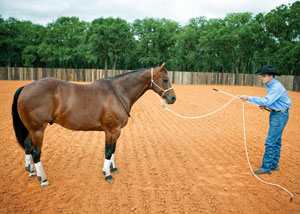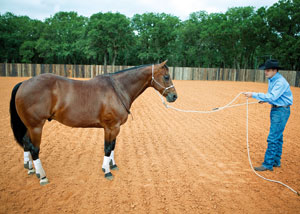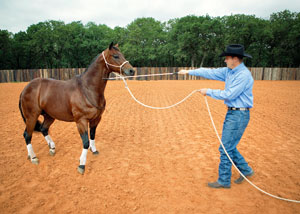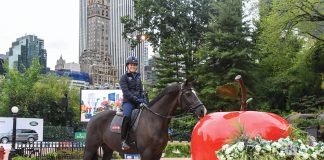It’s important to realize that your horse’s respect for you isn’t automatic; you have to earn it. The best way to do this is by using the same tactics horses use to gain respect from each other.
“When horses are together out in a pasture, it’s very natural for them to establish a pecking order,” continues Anderson. “At first, there is tension in the herd, and fights will break out. But within a couple of days, a pecking order is established and there’s one horse that is the leader of the herd. More often than not, that horse is an old broodmare. How’d she get control of the group? She proved to all the horses in the pasture that she could move their feet forward, backward, left and right.”
The Pecking Order
Horses communicate through body language. Sometimes they will squeal, nicker, neigh and snort, but most of their communication is silent. That boss broodmare relies on a systematic, step-by-step approach to make the other horses move and, therefore, respect her.
If another horse was standing at the water trough and that mare wanted him to move out of her way, she’d approach with a plan. First, she’d pin her ears back. If he ignored her, she’d bare her teeth and act like she was going to bite him. Then she might actually try to bite him. If he still didn’t move away from her, she’d back up to him, swish her tail and act like she was going to kick him. Then she might kick him. And she’d keep kicking until he moved. Whoever moves first loses the battle. All of these steps take mere seconds.
“Even though the boss mare went through several stages of pressure, she didn’t stay at any of them for very long,” says Anderson. “It’s not like she bared her teeth at the other horse for five minutes before she actually tried to bite him. She gave him a chance to move at each pressure level, and if she didn’t get the response she was looking for, she increased the pressure.
“Horses are constantly jockeying for position in the pecking order, trying to move up a spot,” adds Anderson. “On a daily basis, horses in that broodmare’s herd will test her ability as a leader, and she’ll have to prove to them that she’s still capable of moving their feet.”
The same is true for you and your horse. The key to success is that you must be worthy of stepping into the leadership role.
“Horses challenge their own pecking order daily, and they will do the same to you,” says Anderson. “It’s nothing personal; it’s just business. Horses are natural followers, but they want a leader they can respect and trust.”
The No. 1 horse in the herd doesn’t have to be the biggest or the strongest; he just has to be the bravest and the smartest. He has to be the most effective leader. When he tells the other horses to move, they better move or he’s going to back it up with action. Remember this every time you work with your horse. The more you can move his feet, the more control you have, and vice versa. The opposite is also true: The more your horse makes you move your feet, the pushier and more disrespectful he becomes.
Tap the Air Exercise: Clinton Anderson uses this exercise to teach his horse to back away with respect when asked. Tap the air in front of your horse’s nose gently and with rhythm for a count of four. |
 If your horse doesn’t respond to you tapping the air, then tap the rope rhythmically four times, increaing the intensity if he still doesn’t move back. |
 Progress to tapping the clip of the lead rope, and finally your horse’s nose, four times if he still doesn’t back up. |
Earning Respect
Respect is crucial because it opens the door for trust and building a safe, mutually enjoyable partnership between you and your horse.
“Respect must be established from the very first day you work with your horse,” says Anderson. “He should be respectful of you, and you should be respectful of him. It’s a two-way street. Respect is the foundation of control; without it, you won’t be able to control your horse and he won’t be any fun to be around.
“Unfortunately, respect is nontransferable,” continues Anderson. “That means you could buy a well-trained horse, but if you don’t establish a respectful partnership with him, he won’t stay well-trained for long. Just because I have earned a horse’s respect doesn’t mean I can hand him over to you and he will respect you the same way. Each person is responsible for gaining each horse’s respect.”
In conducting clinics around the country, Anderson finds that many people get frustrated because they spend a lot of money on a well-trained horse and within six months, the horse acts like he doesn’t know a thing.
“If I sold you one of my well-trained horses and you took him home and didn’t gain his respect by asserting yourself as the leader and moving his feet forward, backward, left and right, he would go from being a safe, obedient horse to being a disrespectful thug that pushes you around,” says Anderson. “In order for the horse to continue to use the thinking side of his brain and remain respectful, you have to constantly remind him how to use it by moving his feet forward, backward, left and right and always rewarding the slightest try.
“Horses don’t stay the same,” adds Anderson. “Every day they either get a little bit better or a little bit worse. However, if you maintain that respect and improve upon it, your horse’s behavior will get better.”
Leader or Friend?
It’s natural to want to be buddies with your horse, but it’s more important to be his leader. In fact, if you only treat your horse as a pal, he will tend to disrespect you. Some people mistakenly think their horses will respect them once they know they are loved, but that’s not how the horse’s mind works.
“If you only love on your horse, pat him and feed him and never ask him to move out of your personal space, he will never believe that you deserve to lead him,” says Anderson. “The more you shower attention on your horse and feed him treats without asking for anything in return, the more dominating he will become toward you.
“A horse that doesn’t respect you starts to believe that he’s in control of the situation,” continues Anderson. “You can’t treat a l,000-pound animal like a pet because friendship without respect is dangerous. Many situations—working cattle, riding in unfamiliar terrain, jumping a fence—rely on the horse respecting your judgment in order to keep both of you safe.
“I’m not saying you can’t give your horse a treat or that you can’t love on him,” adds Anderson. “Of course you can, and you should. Those are both great ways to reinforce a job well done. Just remember that treats are a bonus. They are not bribes or payoffs.”
Your goal of becoming a good leader will be much easier if you understand how the horse’s brain works and how he reacts to different situations. Without this knowledge, you will struggle with your horsemanship goals.
“Horsemanship isn’t always easy, but it will be easier to understand when you can identify what motivates your horse to act the way that he does,” says Anderson. “When you first introduce a new lesson to your horse, he’s going to get confused, frustrated and maybe even agitated or nervous. That’s absolutely OK. Horses are allowed to express all of those emotions during training. It’s your job as a trainer to learn how to help your horse understand what you expect of him in the easiest way possible.”
Step by Step to Respect
Horses learn best using a step-by-step system. “They’re smart creatures, but they can’t process too many different things at the same time,” says Anderson. “I once realized that if I took the time to break a lesson into steps and introduced each step to a horse separately, he caught on to the lesson a lot quicker and progressed through his training at a faster rate.”
Anderson regularly uses his “Tap the Air” exercise and considers it a foundational tool. The goal is that when you tap the air in front of your horse, he responds by backing away with respect and energy.
“The better you can get your horse to back up, the more respectful and responsive he will be in everything else that you ask him to do,” says Anderson. “A good backup is the foundation of the stop, as well as collection. A respectful horse backs up with energy anytime you want. A disrespectful horse ignores you and walks toward you with pushy, dominant behavior. If you don’t back your horse up, he will get pushier and more disrespectful.”
Follow these steps to practice the “Tap the Air” exercise:
1. Remove the string from your handy stick and tie it around your horse’s neck. Place a piece of duct tape on the lead rope 4 feet from the snap (the length of your handy stick). This is a safe distance to start at when you’re first teaching your horse to back up. The tape will be a reference point and offers an easy way to remind yourself where you should keep your hand on the rope during this exercise.
2. Hold the rope at the duct tape in one hand, and grasp the handy stick like you’re shaking someone’s hand in the other. Stand directly in front of your horse and be sure he has both eyes on you. He can’t give you his attention or respect if he isn’t looking at you with both eyes. If he looks away, bump the halter and lead rope until he focuses on you again.
3. Tap the air in front of your horse’s nose with the stick, gently and with rhythm. Count out loud, “One, two, three, four.” If he doesn’t respond, tap the rope lightly—one, two, three, four. If he doesn’t move back from that pressure, whack the rope more firmly. If he still ignores you, hold the stick horizontally and whack the clip four times. If he still doesn’t respond, whack his nose.
“Your horse’s sensitivity level and how respectful he is will greatly affect how much pressure you’ll have to apply,” says Anderson. “A sensitive horse will require you to use very little pressure. A lazy, disrespectful horse may require you to apply a lot of pressure. Go through the stages of pressure until you get the desired response. Remember, do what you have to in order to get the job done. Do it as easy as possible but as firm as necessary.”
4. As soon as your horse takes two steps back, retreat and rub him between his eyes with the stick. You’re just looking for a starting point to teach him that when you apply pressure in front of his nose, he needs to back away from it. It’s very important to rub him between his eyes with the stick so that he doesn’t get worried about your tools; the goal is to have respect without fear. Be careful not to ask for too many steps in the beginning. Get two steps and then reward; two steps and reward.
5. Once your horse can take two steps back consistently, ask for four consistent steps. In the beginning, he might throw his head up in the air. When a horse has sticky feet, his head goes up. When his feet have energy, his head comes down. Don’t worry about his head; focus on making his feet move. Once they do, his head will come down by itself.
6. When your horse understands the concept of the exercise, expect him to back up with more energy. Continue increasing the pressure until he does. Only release the pressure when his feet are light and energetic. Don’t stop him when his feet are heavy and he’s bracing against the pressure. Horses don’t learn from pressure; they learn from the release of it. Whatever he is doing the second you release the pressure is what you’re rewarding.
7. Each day, ask your horse to take more steps backward with increased energy. By the end of one week of consistent practice, he may be backing 15 to 20 steps.
CYNTHIA McFARLAND is an Ocala, Florida-based freelance writer and horse owner. The author of eight books, her latest is Cow-Horse Confidence: A Time-Honored Approach to Stockmanship, co-authored with Martin Black.
This article originally appeared in the November 2013 issue of Horse Illustrated. Click here to subscribe.






I found this article helpful. I am a new horse owner and could already see how I need to teach my horse to respect me. This article showed mr how to begin implementing it in the correct fashion. Thank you!
The respect issue is a real thing just like Mr. Anderson stated. Ive been around new owners,w/older horses or freshly broken horses. You must have that respect,or it simply will go sour quickly, ive seen owners take horses to auction because they couldnt handle what they initially bought. One was a very close relative and it hurt, turned very bitter in the end. If your scared or fearful in certain areas as a 2 legged animal,be carefull what kind of 4 legged animal you purchase.
Mr. A is right on the money,its about the pecking order,one must establish his rank,after all you will be asking this 1000lb. animal to haul you around. Only an old plug will do this w/out respect. i work w/Arabs, definitly a 50/50 contract.
One thing i feel he left out…over fed,under worked, a recipe for trouble.
Personal space is so important. And respect. With a stallion it’s even more a continuing lesson but well worth the rewards!
I’m not getting any help from nobody I’ve been asking for help with my 17 year old Tennessee walker. When i got him he’d come up to me. I’m not sure where i went wrong with him. he no longer comes to me i have to chase him just to get him to come to me. i had to take apart my calfs pen in order to put it down here for him. I’m just not sure how to go about this horse
hi! Mrs. Handrich if I may I would like to give some advice. I also had that problem with my stallion too. I was working with him almost every day and he began to resent coming to me because he associated me with work. so I just a couple of times would walk up to him with the halter and lead and just rub him and love him to death then I would walk away. I also just a few times walked up to him with the halter and lead and I gave him a treat and would walk away. see the more you ignore the horse the more they want to be with you. like when you fix the fence and you’re ignoring them you couldn’t beat them off with a stick! haha! so maybe try that! hope that was helpful and hope that works for you!! and also try out Clinton Anderson’s website http://www.downunderhorsemanship.com or http://www.clintonanderson.net!! thanks!!
I tried this and my horse either moves toward me or just stands there… Anyone have suggestion?
I have this horse and I’m not sure what to do with her. She was never taught any boundaries or ever been disciplined. I’ve been trying to do respect exercises but she misinterpretes them as a signal of fear. I’m very confused as to what to do. I don’t want her to fear me but I want her to behave well also. Any suggestions would be extremely appreciated.
Excellent!